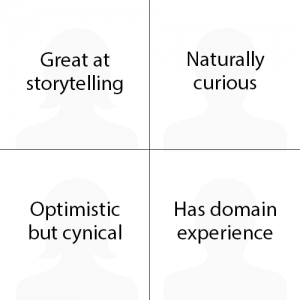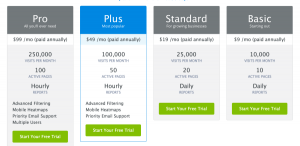
“Marketing is no longer about the stuff that you make, but about the stories you tell.” Seth Godin
When you publish a textual blog post, you can tell how engaging it is through comments, social sharing, bounce rate and so forth.
Yes, you can determine the average time visitors spent on your textual page but you have no means of determining the exact paragraph(s) that grabbed their attention, unless they explicitly mentioned that in the comments.
Videos, on the other hand, empower you to gain an in-depth understanding of your audience content consumption preferences and turn-offs. Thanks to the advanced video marketing analytics tools, you can figure out the exact video content that a particular viewer watched (or rewatched), which links on your videos they clicked on, and their entire video viewing history.
This information can be invaluable for accurate lead scoring and nurturing which, in turn, yields more sales conversions and increased ROI.
In the first article in this series, The Ultimate Video Marketing ROI Cheat Sheet (Part 1), I detailed video content best practices and video SEO proven tactics for optimal ROI.
In this article, I will be focusing on video marketing analytics tips and insights.
But before getting there, keep in mind the top 3 common reasons for business video production:
- Corporate Branding
- Lead Generation
- Customer Acquisition
Knowing your exact video marketing objective will be the foundation upon which you can determine the most important video marketing analytics metrics to focus on.
In addition, your video publishing, promotion and distribution channels will largely depend on your preset objective as well.
Video Marketing Platforms (VMPs)
Most video sharing websites such as YouTube and Vimeo offer excellent video analytics tools for free. In addition, private hosting services (such as Vidyard and Wistia) offer highly advanced video analytics capabilities.
Due to the rapidly increasing importance of video marketing, a wide variety of video marketing analytics solutions are launched every day in order to equip businesses with all the tools they need to boost their video marketing ROI.
Top 5 Most Important Video Marketing Analytics Metrics
1. Watch-time
As the name implies, the watch time metric measures the time users spend watching your video. Free video sharing tools such as YouTube provides you with the average view time of your video filtered by a specific time span and geographic location. This information provides a general assessment of your video view time.
Even more importantly, you can use advanced video marketing analytics tools to determine the exact video watch time for every user. This invaluable metric will empower you to customize your lead nurturing cycle according to the unique preferences of your audience.
2. Repeat Watches
If a user watched your entire video or a part of it more than once, it can mean two possibilities:
- The rewatched part of the video is very compelling and engaging that viewers had to watch it again and again
- The rewatched part of your video is difficult or confusing so the viewers had to repeat watching it in order to get a better understanding of its content
In either case, being able to pinpoint the exact sections of your video that have been rewatched by the same user can be tremendously helpful in boosting your video marketing ROI.
HubSpot beautifully summed up the massive rewards of measuring video repeat watches:
Using this metric, salespeople have the potential to be far more successful at making a sale. By focusing on which sections of the video have been rewatched by an individual lead, they know exactly which pain points to address once they get on the phone. For example, a salesperson might take extra time explaining the enterprise product price structure because he saw that his lead rewatched the section on pricing three times. Mike goes into every call even more prepared because he already knows what the lead is concerned about — and he has a solution that could help.
On top of that, you can make the most out if the view time and the repeat watches metrics combined by creating super-targeted email marketing segmented according to common viewership preferences of your audience.
For example, if users A, B, and C watched the same section of your video repeatedly, you may add them to separate email marketing list where you can further nurture them and follow up with enticing content that addresses their interests and pain points.
Giving special attention to viewers who showed repeated interest in your video content can magnify your chances of turning them from qualified leads into paying customers.
3. Engagement Rate
Engagement rate = watch time / video length
This metric is a very important indicator of how viewers react to your video content. The higher the engagement rate, the higher your video marketing ROI and vice versa.
Did you know that Google ranks videos according to watch-time (not number of views)?
In other words, if you have a 5-minute video that a user watched for 10 seconds, it will not help your ranking in any way. That’s why; I excluded the views metric from this list.
You may compare video views to Facebook pages likes. Some users may like your Facebook page but never visit it afterwards. In this case, they wouldn’t contribute in any meaningful way to your Facebook marketing ROI.
Still, having more page likes gives an instant indication of how popular your Facebook page is.
Similarly, when you make a YouTube search and get several videos in the results, which one do you pick?
I usually go for the one with the highest views as it looks popular and promising at a glance. However, if I wasn’t compelling enough, I would bounce in a heartbeat!
That’s why; you should aim for a high video engagement rate by consistently measuring this metric and tweaking your video content accordingly.
4. Conversion Rate
Conversion rate is the percentage of audience who convert (perform the required action) compared to the total number of video views at a specific time frame.
For example, if you have a video that links to a sales page and 2 visitors watched that video on the same day. If one of them clicked on your sales page and made a sale, then you would have a 50% conversion rate at that day.
Its important to note that the term conversion is not limited to sales as your video CTA (call-to-action) may lead to a landing page where users opt-in to your mailing list. In this case, making a conversion would mean turning a website visitor into an email subscriber.
In other words, conversion is a broad term that refers to getting users to perform the expected action.
Advanced video analytics tools enable you to track when did your viewers stop watching your video (watch-time) and where did they click next. Did they go to the sales page halfway through the video or did they bounce after few seconds?
Being able to precisely measure your video conversion rate will give you a clear indication of your overall video marketing performance.
5. Play Rate
Play rate is the percentage of page visitors who watched part of (or all of) your video compared to the total page visitors at a specific time frame.
You should aim for a 100% play rate. In order to maximize your play rate, you need to tweak your video surroundings such as video thumbnail and video title as these are the initial triggers that page visitors must find attractive enough to watch your video.
Integration Integration Integration!
Consider this scenario: If you have 100% play rate and a 2-second watch-time for the same video, don’t expect the high play rate to contribute to your video marketing ROI!
What if you’re only measuring play rate? In this case, your numbers will be completely misleading.
In other words, you need to measure the 5 metrics and assess your video marketing performance based on the outcomes of all of them combined.
In addition, advanced video marketing analytics tools (such as Vidyard) enables you to integrate video marketing with popular CRM and marketing automation tools.
In this case, if a user provided their contact information via your landing page, his entire video watching behavior will be tracked as well as his reaction to other content forms, including downloading a whitepaper or attending a webinar and so forth.
In addition, their blog/video comments, likes and shares coupled with all their social media interactions with your brand are all tracked in one place. The integrated sum of all of these activities will be used for lead scoring and nurturing.
Integrating video data with your CRM and marketing automation platform will empower you to fully tap into your leads needs and expectations from your brand and offer it to them on a silver platter. In the process, your overall digital marketing ROI will soar.
Where Do You Go From Here?
The key takeaway from this article is that video marketing should be regarded as an inseparable entity from your overall digital marketing campaign.
There are excellent tools out there that enable you to tie everything you do online together for optimal results. Consider investing in one of them. You will be glad you did. To your success!
Now Read:
- The Ultimate Video Marketing ROI Cheat Sheet (Part 1)
- Online Video Marketing: 7 Hot Tips To Maximize Your Video To Generate More Sales Leads
- 5 Video Content Types & What You Should Understand About The Importance Of Video Marketing
Next Steps:
- The Ultimate Video Marketing ROI Cheat Sheet (Part 1)
- Online Video Marketing: 7 Hot Tips To Maximize Your Video To Generate More Sales Leads
- 5 Video Content Types & What You Should Understand About The Importance Of Video Marketing
Hand-Picked Related Articles:
- The Ultimate Video Marketing ROI Cheat Sheet (Part 1)
- Online Video Marketing: 7 Hot Tips To Maximize Your Video To Generate More Sales Leads
- 5 Video Content Types & What You Should Understand About The Importance Of Video Marketing
* Lead image adapted from Fabien Agon
The Ultimate Video Marketing ROI Cheat Sheet (Part 2)
The post The Ultimate Video Marketing ROI Cheat Sheet (Part 2) appeared first on Search Engine People Blog.
(101)
Report Post






